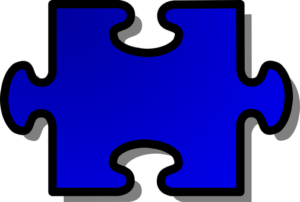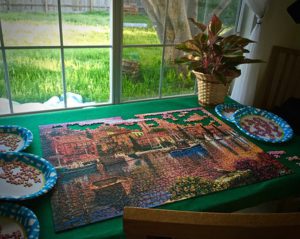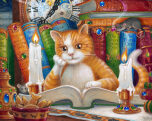Have you ever wondered who thought of the idea of jigsaw puzzles? Actually, these first started from a painting. One cut a picture on a flat, rectangular piece of wood into small pieces using a jigsaw. Thus the jigsaw puzzle got its name. John Spilsbury, a London cartographer and engraver, made the first commercial jigsaw, around 1760. This first jigsaw showed a map of the world.
HERE ARE A FEW PUZZLE FACTS
In the early 19th century, the recipients of puzzles became for the most part children of wealthy families. The puzzles often adapted the idea of educational themes.  Then, puzzles for adults appeared, and became very popular.
Then, puzzles for adults appeared, and became very popular.
The end of the century saw the invention treadle-operated jigsaws. Also, wood became available in thin sheets, and printing improved considerably. These advances allowed puzzle-makers to add much more durable designs, as well as more intricate and colorful.
During this period, Raphael Tuck, a German furniture dealer, developed techniques that set the stage for the next century of jigsaws. Cutting became more intricate. Puzzles now included “whimsies,” pieces cut into recognizable shapes. Puzzle-makers started using plywood or thick card stock for making puzzles.
Raphael Tuck’s ideas soon got adapted in America, and by 1908, puzzles became a full-blown craze. By 1929, Americans bought two million jigsaws a week.
To meet this demand and to save costs, some manufacturers developed the technique of “stack cutting.” Up to eight puzzles could be stacked on top of each other and all cut at the same time.
In the 1920s, an American company developed a technique for die cutting cardboard puzzles. This reduced production costs to a fraction of the cost of hand cutting. Now, with the improved quality of printing, superb images became available at a reasonable price.
Check out the Guinness World Record for the largest commercial jigsaw puzzle in the world, both in number of pieces and finished size. The puzzle, “Memorable Disney Moments,” contained 40,320 pieces and measured about 22 1/2 feet wide by 6 1/2 feet high, and weighed in at 43 pounds
HEALTH BENEFITS FOUND IN PUZZLES
Working on jigsaw puzzles or crosswords can provide many health benefits to the brain. The brain produces a chemical known as dopamine. This chemical is quite important because it is chiefly responsible for learning and memory. When engaging the brain in solving puzzles, the production of this chemical increases.
Because working puzzles stimulates concentration and strengthens short-term memory, puzzles benefit us by helping reduce the risk of dementia.
THE JIGSAW CLASSROOM TECHNIQUE
In education, there is something called the jigsaw classroom technique. This is a method of organizing classroom activity in such a way as to make the students depend on each other to succeed. Classes are broken into groups and assignments are broken into pieces. When the group assembles these pieces, they complete the puzzle.
HINTS ON PUZZLE SOLVING
 Here are some suggestions for puzzle completion. First, sort the pieces by color, using the picture on the box for a guide to color and shape groups. Find all the edge pieces and assemble. Then do the center, using your color-sorted groups.
Here are some suggestions for puzzle completion. First, sort the pieces by color, using the picture on the box for a guide to color and shape groups. Find all the edge pieces and assemble. Then do the center, using your color-sorted groups.
When your frame of edge pieces is finished, leave the center of the frame free of pieces, putting in only completed sections. This makes your building job much easier.
Then take your pieces sorted by color, and see if some will combine to make small sections. Look for colors along the edge that match your color groups.
Consult the picture on the box often. Walk around the table to view the puzzle from a different angle. For extra assembling assistance, you can purchase a felt puzzle board that will keep your pieces safe and in place. When you are done working, you can roll the felt board up and store it.
Some people glue their puzzle pieces to a permanent surface and display them as art.
(Information for this article comes from Wikipedia and from jigthings.com
SELECT A PUZZLE ABOUT CATS FOR YOUR FAMILY FUN

by Vermont Christmas Company
Prime
As an Amazon associae, I earn from qualifying purchases.
The Cats of Charles Wysocki: Frederick The Literate
750 Pieces
Prime
As an Amazon associate, I earn from qualifying purchases.
by White Mountain Puzzles
1000 pieces
Prime
As an Amazon associate, I earn from qualifying purchases.
by Buffalo Games
300 Large Piece Puzzle
As an Amazon associate, I earn from qualifying purchases.
Kittens Fishing — 550 pieces
by Vermont Christmas Company
Prime
As an Amazon associate, I earn from qualifying purchases.
Sun’s Out On The Shelf– 1000 pieces
by SUNSOUT INC
Prime
As an Amazon associate, I earn from qualifying purchases.
Tapestry Cat — 1000 pieces
by White Mountain Puzzles, Inc.
Prime
As an Amazon associate, I earn from qualifying purchases.
Curious Kittens — 1000 pieces
by White Mountain
Prime
As an Amazon associate, I earn from qualifying purchases.
The Witching Hour 80013 1000 piece
by Cobblehill
Prime
As an Amazon associate, I earn from qualifying purchases.










This is a great post, I have learnt many new things about cat puzzles. Very informative and interesting post, keep up the great work you’re doing. Looking forward to reading more posts from you.
Habib
Puzzles were a great invention, and are a force for good, I believe. It is not always easy to find activities that the whole family will enjoy, but I think puzzles fit that bill. I am so glad you enjoyed my post, and do hope you return often.
This is a really interesting and informative post. I like the jigsaw classroom technique because it encourages teamwork and cooperation between students. I didn’t know that solving puzzles can help increasing dopamine level and reducing the risk of dementia. It’s great to know, thanks for sharing!
Thanks for your comment, Blanka. Yes, it’s nice to know that doing something that is so much fun can actually help your brain. Too often we are supposed to avoid those fun things. Life is a bit of a puzzle, isn’t it? It is rather nice to have something we can actually solve. Glad you enjoyed my post. Please come back again to visit.
Hello Fran,
This was a very interesting article. I love jigsaw puzzles and I did not know about their origination. I will share this with my daughter. She is a puzzle wizard. Thanks for sharing this delightful information. Nice website too.
Keep up the good work.
Michelle
Thanks for your comment, Michelle. Yep, these puzzles look like fun to me. Wouldn’t mind having one of them my own self!
Hi there, I really enjoyed reading about the history of puzzles. As I also love cats, the idea of a cat puzzle was very intruiging and I was stuck when it came to choosing a favourite.
Puzzles are similar to Lego when it comes to brain development although kids love them differently (if that is clear!).
Personally, I find puzzles with 1000s of pieces quite daunting to put together, but your tips really make sense and the thought of assembling jigsaws is not so scary now.
Thanks for sharing!
I am so glad you enjoyed my post. Yes, there are some nice ones there. I want to choose a puzzle or two for myself, but am not sure which one I like best.
By the way, there is one puzzle on the list that is, I think, 350 pieces, if that is any help. And, yes, I do feel that puzzles, like crosswords, will help keep the brain alert and functioning well..
If you end up trying one of the 1,000-piece ones, let me know if it was any easier to assemble this time.
Thanks much for your comment.
Very nicely done all the way around. Quite professional. Your history of jigsaw puzzles is quite interesting, and, yes, being a cat lover I would enjoy a puzzle. The layout is quite good, with quality graphics placed strategically as to balance the page and draw the eye. The pic at the top immediately grabbed me. “Cat Tales”, “Cat College” are both topics that I would like to explore. I have nothing negative to say, just a very attractive and classy piece of work. Thanks!
How nice of you! So glad you liked the site. Do come back and visit again when you get the chance. There is a lot of information in “Cat College” and fun stories in “Cat Tales.”
Interesting read about the history of jigsaw puzzles. When I was a child I loved doing puzzles, and my Mom does puzzles all the time. I always buy her puzzles for Christmas, so I might have to get her one of these. Great tips on how to sort the puzzle pieces by colour and shape. I will have to share those tips with my Mom.
Puzzles are fun, and I think I need one my own self. It’s been too long. I love those tapestry cat puzzles. They look like a lot of fun. Glad you enjoyed the little bit of history, and hope you decide your mom can’t live without one of these cat puzzles at Christmas this year.
I love your article, because I love cats, and I love puzzles. As a child, the thing I look forward to most about school holidays is the chance to bring out all my jigsaw puzzles from the storage, and fix them. One puzzle at a time, I would fix it up over a few days, depending on the number of pieces, admire the finished work for a few seconds, and totally dismantle it to pack it back into the box, just to start on the next puzzle. I guess that’s how an introvert spends all her free time, haha. I get so much joy and fulfillment from this past time.
My favourite from your selection is the Tapestry Cat. 1000 pieces is a fantastic number for me, just the right amount of challenge.
So glad you liked the puzzles — and I think the Tapestry Cat is my favorite too. In fact, thinking of buying one of my own puzzles. That would make a great holiday diversion. Do keep them in mind as the holiday approaches. And, by the way, as you love cats, I have some great cat Christmas cards on the site…just put them up yesterday. You might like them.
It’s like you created this website just for me! I love cats! And I love puzzles! This is a website that I could return to again and again. You have some great information here. I like your Hints On Solving Puzzles section. I’m curious… How do you recommend solving a puzzle with irregular pieces (no straight edge border), and all in one color?! I just recently experienced one of these for the first time, and it was a challenge! I looked for “landmarks.” Not sure if that was the best strategy, but it worked! My favorite puzzle above is the Tapestry Cat.
Now, the puzzle with irregular pieces and all in one color sounds to me like a recipe for instant insanity! How long did it take you to finish it? I think I’d rather stick to puzzles that have pictures. And, you know, I have had two other comments today saying the Tapestry Cat was their favorite. I think it is mine, too….might have to get one my own self. And, by the way, would love it if you returned again and again.
I love this article! I remember to spend hours with my father just playing with a jigsaw puzzles. We finished two about cats and a bunch about other things. We simply found it to be relaxing and a family activity. Even though I was 17 years old, it was a fun way to spend the Sunday at home.
I’m looking forward to one day do that with my own kids! My daughter is almost 6, so I’m sure that in a few years, she will find fun to play with a 1000-piece jigsaw puzzle about cats. By the way, I have one cat! his name is Pipo and he is almost 9 years old 🙂
I’m glad you enjoyed the story. Yes, I think many of us have memories of sitting around a table with family or friends and working on a jigsaw puzzle. I know I used to love puzzles. It’s challenging, good for the brain, and good for family bonding. And, I am glad you have a cat to enjoy. They are wonderful family members.
Hi thanks for the great read, I’ve never thought about where puzzle came from but I’m a nerd and I like learning random things. I did have a few questions: You mentioned the first puzzle that was cut thus creating the name jigsaw but who did the cutting and how did the idea arise? Also I liked one of the puzzles you illustrated but I didn’t see where I could click to get more information to potential buy one. Could you please include purchasing information, thanks
Hi, Kelly. Here are some answers to your questions. The first puzzle was made in 1760 by a London cartographer and engraver named John Spilsbury. The jigsaw was developed during the same era, and became the standard tool for making the puzzle, so it began to be called a “jigsaw puzzle.” Interesting bit of info: The first puzzles were maps, and the puzzles were cut along boundaries shown on the map. Thus a puzzle could be used as a teaching tool. As to purchasing information: Click on the picture of the puzzle and it will take you to the seller. I would put links on the puzzle names, too, but I had a terrible time with the links for that company,and don’t know if I’m brave enough to try to do the text links. If you have more questions, just ask.